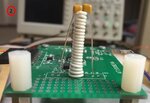lichengjun
Junior Member level 2
Hi,
I have a capacitance measurement board which can convert input tiny differential capacitance to voltage. I found a strange thing about it. Whenever I use it to measure constant differential capacitance on weekdays, I can always get stable result as shown below, which is normal.

But every time I use it on weekend, I always get oscillating result.

Can anyone tell me why?
Thanks.
I have a capacitance measurement board which can convert input tiny differential capacitance to voltage. I found a strange thing about it. Whenever I use it to measure constant differential capacitance on weekdays, I can always get stable result as shown below, which is normal.

But every time I use it on weekend, I always get oscillating result.

Can anyone tell me why?
Thanks.




